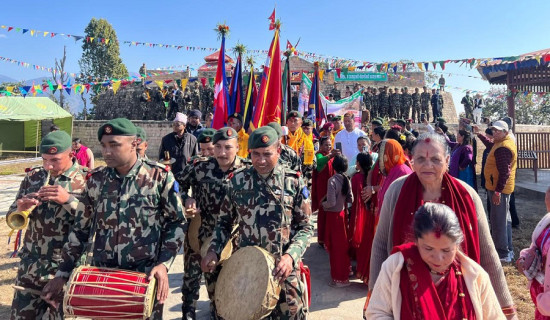- Thursday, 8 January 2026
A Tale Of Two Maps
A mural illustrating the concept of Akhanda Bharat (undivided India), has recently generated controversy among South Asian nations. The map, placed within India's newly-built parliament building, is characterised as a cultural map of the old Indian subcontinent. However, it includes parts that belong to Nepal, Bangladesh, and Pakistan. Many Nepalis raised objections to the mural, particularly about the inclusion of Lumbini and Kapilvastu, which are historically significant sites in Nepal. Bangladesh expressed its dissatisfaction by sending a diplomatic note to the Indian High Commission in Dhaka, while Pakistan also protested.
To allay tensions with neighbouring nations, the Indian side, notably Foreign Minister S. Jaishankar, stressed that the map presented in the parliament just shows the cultural facets of ancient India. Interestingly, following the mural's public display, the map of Greater Nepal began resurfacing as numerous Nepalis shared it on social media platforms as an expression of Nepali nationalism and as a response to what they perceived as a violation of Nepal's sovereignty through the inclusion of Nepali historical territories in the Indian map. Some media outlets even stated that Kathmandu's mayor, Balendra Shah, too displayed the Greater Nepal map in his office, sparking a hot discussion on the two maps.
Greater Nepal map
Meanwhile, the Greater Nepal map incorporates lands that were acquired by the forces of Nepal during and after the unification under Prithvi Narayan Shah. During later years, the Gorkha Kingdom successfully annexed various areas, including major parts of present-day Uttarakhand, Himachal Pradesh, and portions of northern West Bengal and the Ganges plains in India. This period of geographical growth marks the peak of Nepal's size, frequently referred to as "Greater Nepal."
However, the unification drive was halted by the British East India Company. The Gorkha forces and the British Indian army fought in the Anglo-Nepali War (1814–1816), resulting in Nepal's defeat and the loss of a substantial section of its lands. The idea of Greater Nepal remains significant in Nepali history and continues to be a symbol of national pride. However, Nepal's present-day borders are determined by international accords and treaties, and the government recognises and acknowledges these limits within the framework of international law.
In the meantime, the mural in the Indian parliament refers to the idea of a unified and undivided India that includes not just the present-day territorial limits of India but also places that were historically part of the Indian subcontinent but are now ruled by other countries. However, establishing an undivided India is problematic because of geopolitical constraints, historical conflicts, and the aspirations of many nations and groups in the region. Each country in the region has its own particular identities, aspirations, and political dynamics.
Nepal's growing discontent with the Indian mural is directly tied to the unresolved border conflicts between Nepal and India. The inclusion of Nepali areas such as Kalapani, Limpiyadhura, and Lipulekh in India's political map prompted a cartographic tussle. In 2021, the administration of the former Prime Minister, KP Sharma Oli, issued a political map that included these disputed areas. Historical papers and evidence have established that these lands belong to Nepal; however, India has positioned its army in these areas, deeming them ‘sensitive and strategic because of their location at the tri-junction of Nepal, India, and China.’
While Nepal continues to experience issues over border encroachment at various places by the Indian side, is it a favourable idea to raise the idea of Greater Nepal? Some media persons and analysts urge that the people of Nepal should not fall into the trap of the Greater Nepal concept. They say that if Nepal were to regain the land it claims as part of Greater Nepal, the number of Hindi-speaking people in these areas, which today lie within Indian boundaries, would outnumber the Nepali-speaking population. For example, if Nepal were to regain these areas, the number of Hindi-speaking people would increase by nearly 70 million, while there are only 30 million Nepali-speaking people. This will surely lead to an overwhelming number of Hindi-speaking people, even creating an existential threat to Nepal.
Strategy
Other factors firmly reject any attempt to reclaim lands that Nepal won but surrendered after the 1814–1816 Anglo–Gorkha conflict. It would be silly to think that India, a rising economic power, will yield these lands to help Nepal accomplish its aim of becoming Greater Nepal. The idea of a Greater Nepal appears to be a strategy for opposing India and building a nationalist spirit among the Nepali population. However, this does not mean that Nepal should not voice its objection to or take firm action to quell any illegal land encroachments by outsiders. It is vital for Nepal to consistently explore every feasible route to reclaim its encroached territory at the present moment.
Given the current circumstances, it appears rather tough for our leaders and top officials to address Nepali concerns that include land encroachment by India, the imbalanced Nepal-Indian Peace and Friendship Treaty of 1950, the need for an understanding or treaty on sharing water, electricity generation, and other resources, and finding a durable settlement. Additionally, the topics of exporting power to India and addressing trade imbalance concerns with India are heavily discussed topics in Nepal and need permanent answers. Our leaders often remain unsuccessful in convincing their Indian counterparts to address Nepali concerns on problems related to the aforementioned issues.
However, the increased level of awareness among the general public concerning our relationship, issues, and problems with India is a positive indicator. This awareness keeps our leaders and bureaucrats watchful and stops them from succumbing to the pressures exerted by neighbouring nations. It ensures that decisions are not damaging to the well-being of our nation.
(Upadhyay is a former managing editor of this daily.)
















